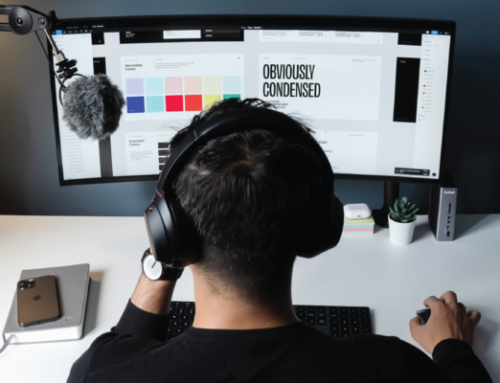5 Tips and Tricks for Giving Effective Web Design Feedback
When you look at a website design, you just know it’s not going to work. You can’t exactly remember how you saw it in your brain, but you know the website design your designer gives you isn’t it. In fact, it’s a long way from what you envisioned. But how will you communicate this to your web designer?
One of the most difficult tasks is providing constructive feedback for a website. It’s nearly impossible to avoid being subjective. But, before you call your designer and say, “something isn’t working,” let us help you provide feedback that delivers you the best results.
We’ll go over some hints and tricks, as well as feedback on website design examples and an Effective Web Design Feedback form.
Our first tip is to:
Before you give your web designers feedback, take a moment to consider your website from the perspective of a visitor. When you analyze their personality, background, and goals, the type of website you want becomes easier to visualize and comprehend. So, while the website design may not be your cup of tea, it appears to be popular with your target group.
For example, if you’re designing a website for people of a different generation than yourself, this could be the case. You might be in your 20s and think that the best web design is all about following trends and using unique solutions like parallax scrolling. But your audience in their 40s doesn’t care and would rather navigate through a more minimalistic, straightforward design.
That’s why, when it comes to web design, you should get to know your target audience and put yourself in their shoes. Make buyer personas and then ask yourself, “Would this be something they’d enjoy?” Why do you think that is?
To take it a step further, try directly asking your users what they think of the web design. You can solicit feedback from your visitors in a variety of ways. Here is some feedback from your audience on website design examples:
Pop-up surveys
The pop-up survey could show up right in the center of your visitor’s screen, forcing them to choose whether to fill it out or close the window before going to your website’s content.
But don’t go too far with the questions in the pop-up surveys, or you’ll annoy your customers and drive them away. Instead, limit your questions to the most important ones and make them multiple-choice so that the visitor can quickly select an answer. Keep in mind that no one wants to waste more than a minute on a pop-up survey.
Feedback widgets
Eventually, you have the option of using a feedback widget. It is a button that your users can click to rate their overall experience and sometimes answer a clear question that will assist the company in improving their user experience.
Regardless of the method, you need to be able to provide a more objective review of the website design.
2. Try to add value with your feedback.
It is more important than you might think to provide useful web design feedback. According to a Stanford University study, 75% of users judge a company’s credibility based on the design and UX of its website. Worse, it doesn’t take long for your visitors to form an opinion about the design of your website! According to the studies, a typical user forms an impression of the website they’re visiting in less than two seconds.
All of this demonstrates the importance of being able to provide valuable and helpful feedback to your designers. But how exactly do you go about doing that?
Well, keep in mind that every point of view you express should make sense to your designers and contribute to the overall success of the project. For example, you could request that your design team “enlarge the brand logo.” Of course, in some cases, this could be an example of effective feedback. What if making your logo too large diverts your visitors’ attention away from an important CTA, lowering your conversion rate?
Alternatively, you may want to cram a couple of visuals into the page, but this may end up cluttering your website and leaving no room to breathe. So, as previously stated, ask yourself, “Will adding this graphic visual I really like impress my visitors or divert their attention away from the core message?”
3. Avoid using vague or non-specific phrases.
Most people have a hard time distinguishing personal preferences from business requirements. You may enjoy blue, but keep in mind that your visitors may not. This being said, there will always be something in the design that reflects your personal taste, which is perfectly acceptable.
Meanwhile, before you start the design process, make sure your designer understands what you’re looking for. You and your partner can create a design brief that you both agree on at the start, which will help you avoid misunderstandings later on.
Even the most difficult feedback can be delivered in a polite manner. Try using the sandwich approach, in which you start by highlighting the project’s positive aspects, explain the project’s flaws in the middle, and end on a high note.
If you take web design feedback seriously, you’ll learn how to avoid ambiguous language and get straight to the point.
4. Start a discussion
An Effective Web Design Feedback is never a one-sided opinion. The majority of the time, the web designer and the owner have an open dialogue. This is why, rather than asking your designer to change something you don’t like, try to find out why they chose the solution they did. After all, they know everything there is to know about UI and UX design, so perhaps they can explain why their version is superior and persuade you to keep it.
Instead of making direct comments, ask questions to open a dialogue between you and the design team, transforming everything into effective teamwork.
5. Have faith in the process.This is a common misunderstanding
We understand that we covered a lot here, and you may be feeling overwhelmed as a result. Our final piece of advice is to not overthink it. You chose your designers, so you must maintain trust and respect for them and believe that they will solve any problem and produce excellent results.
Be patient with the design process because it takes a lot of time and effort. One of the most important aspects of giving and receiving feedback is trusting the process. The first draught versions may differ significantly from the final versions, which is perfectly acceptable. Meanwhile, all you have to do is communicate clearly and honestly with the team.







